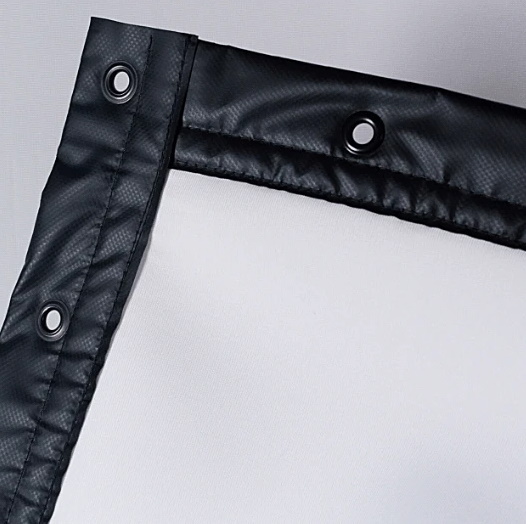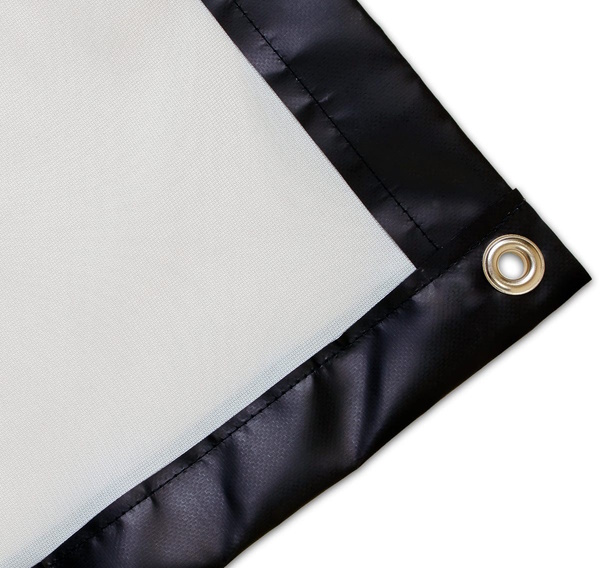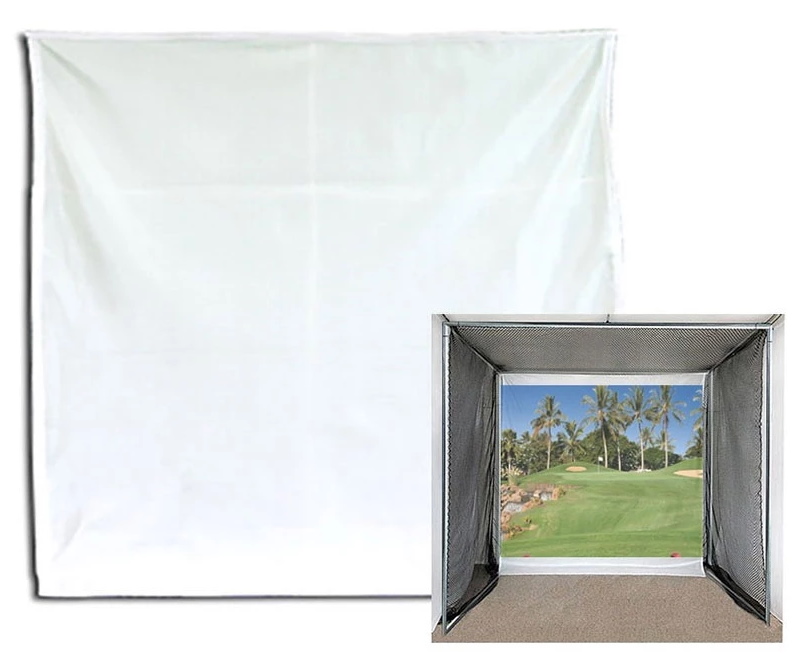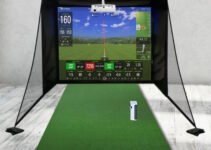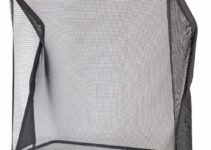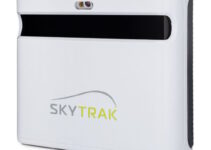Golfstead is reader-supported. When you buy through links on the site, we may earn an affiliate commission at no extra cost to you. Our affiliations include, but are not limited to, the eBay Partner Network and Amazon Associates.
The impact screen is a crucial aspect of any complete golf simulator setup. If you can find a way to hang it, it can also be used in lieu of a net when simply hitting balls without a projector.
Quality screens are designed to withstand thousands of high-speed golf ball impacts. Among other things, they should contain balls safely, produce a good image, have minimal bounceback, and be made of durable materials that will last.
Hence, when building out a golf simulator, it’s not good enough to just put up any piece of fabric. You need to think about the impact screen or else you won’t be able to realize the full potential of your simulator.
In this article, we’ll review and compare our picks for the best golf simulator impact screens across a range of different prices. We’ll also provide a buying guide that will help you narrow down the screen that will suit you best.
Note: Golfstead has tested and/or conducted in-depth research into all of the products featured in this guide. Our editorial process for these rankings takes into account a mix of many factors which may include performance, reliability, usability, value for money, cost, and the general consensus from other users of the product. The list that follows may be reassessed or updated over time.
Our Top Picks For Golf Impact Screens
The following are our top selections based on our own testing, research, and experience:
- SIGPRO Premium Golf Simulator Screen
- Carl’s Place Golf Simulator Impact Screen
- RS Tour Premium Golf Simulator Impact Screen
- The Net Return Pro Series V2 Flex Simulator Screen
- Cimarron 10’x10′ Impact Projection Screen
1. SIGPRO Premium Golf Simulator Screen
The Indoor Golf Shop’s SIGPRO Premium impact screen is a result of months of development working with one of the best mills in the world.
In fact, MyGolfSpy found in its head-to-head test that the SIGPRO Premium outperformed the most popular impact screen on the market and is generally superior to the competition.
It has excellent longevity, produces a quality image, and has reduced sound and bounceback. Moreover, it’s available in a wide range of different sizes (up to 10’x10′) and aspect ratios to suit your requirements.
Features
Let’s start with the screen material. The fabric is thick and smooth, consisting of vertical spacer yarns that are sandwiched by two heavy-duty, impact-resistant, tight-knit polyester surfaces. The result is a unique triple-layer surface that:
- dampens the noise of golf ball impacts
- absorbs more of the impact resulting in less bounceback
- reduces the amount of time a golf ball spins while in contact with the screen, thus reducing wear
The smooth spacer mesh fabric minimizes bleed-through, does not suffer from pixelation or a grain effect, and is capable of producing crisp 4K images.
The screen is surrounded by black double-stitched vinyl edges and grommets. The finished edges contain heavy-duty hook-and-loop Velcro, allowing easy integration with netting, bumper borders, enclosure blackout walls, etc.
The SIRPRO Premium screen can withstand ball speeds of up to 250 mph and comes with a 1-year performance guarantee. You may also be able to upgrade the screen to a SIG enclosure at a later time.
We love this screen and think it has so much to offer, but if it’s a little pricey for you, check out The Indoor Golf Shop’s more affordable SIG Preferred screen.
2. Carl’s Place Golf Simulator Impact Screen
Looking for just a screen? Making a DIY enclosure? Whatever your reason for wanting a standalone screen, one of the best ones you can find right now is from Carl’s Place.
What makes ordering an impact screen from Carl’s Place so attractive is the amount of control you have over the customization. In addition to being able to choose from over 27 different sizes, you can choose a screen material and a finishing style.
Carl’s Place impact screens are sewn in-house, and they can even accommodate custom sizes, edges, finishes and materials.
Features
Carl’s Place golf simulator impact screens have a durable build and are designed to withstand balls travelling at up to 250 mph. The material options are:
- Standard: loosely woven polyester; a budget-friendly option
- Preferred: smoother texture with better durability; tightly woven polyester fibers for better image quality
- Premium: triple-layer, heavy-duty, impact-resistant polyester; a smooth surface with dampened noise and an HD image
There are also three different finishing options:
- Classic: consists of 2.5″ black vinyl edges and grommets all the way around the screen.
- Classic with Loop Fastener: a classic finish enhanced with 1″ loop fastener strips all the way around the screen.
- Classic with Flaps: a classic finish enhanced with 7″ flaps and edged with 1″ loop fastener strips all the way around the screen.
Carl’s Place provides absolutely everything you need to get the screen you want, and then to maintain the screen and keep it clean as best as possible. They provide a wealth of information in that regard in their Resources and FAQ section here.
The Carl’s Place impact screen is priced very affordably given the amount of flexibility and customization at your fingertips.
You can alternatively get the new Carl’s Place C-Series screen which has a borderless bottom. When used in an enclosure system, this results in a seamless transition from turf to screen. This screen currently must be purchased as part of a Carl’s Place C-Series Enclosure.
3. RS Tour Premium Golf Simulator Impact Screen
The RS Tour is the exclusive impact screen offering of Rain or Shine Golf. It’s the same screen used in their successful SwingBay enclosure system.
This screen is edged with 3/8″ nickel grommets, ready to be attached to or hung from a frame. Its durable construction consists of a ballistics-grade woven polyester blend and vinyl-coated polyester border. The tightly-woven fibers are conducive to a crisp and bright projection image.
The RS Tour screen is built to withstand ball impacts up to 250 mph. You can hang the screen with Rain or Shine Golf’s frame ball bungees.
The screen comes with a 6-month warranty and is currently offered in at least five sizes including 8 ft x 10.5 ft (4:3), 7.7 ft x 10 ft (4:3), 9 ft x 12 ft (4:3), 8 ft x 14 ft (16:9), and 9 ft x 16 ft (16:9). Custom sizes are available upon request.
We like the simplicity and competitive pricing of the RS Tour relative to other impact screens with similar specs. Note that you can also pair the screen with wall mount or ceiling track curtains.
4. The Net Return Pro Series V2 Flex Simulator Screen
This is an excellent no-frills simulator screen from The Net Return that is designed to be used with The Net Return Pro Series Net.
Unlike the original Pro Series screen which just hung from the top, the new version now features grommets on the four corners where bungees can be used to secure the screen to the net.
With the Pro Series V2 Flex screen, you can switch from golf simulation (with a projector) to general practice within a minute. It’s one of the most affordable solutions out there today.
How It Works
You can use the Pro Series Simulator Screen with any golf simulator software and projector. Made of white polyester fabric that can take even the most monstrous drives, it:
- can project a crisp, bright image
- absorbs the sound of golf ball impacts
- minimizes bounceback and puckering
Its size is 84″ high x 85.5″ wide — make sure you have enough space.
There are a couple things you should note:
- We recommend projecting at a 4:3 aspect ratio because of the shape of the screen. If you use 16:9, there will be a lot of white space.
- The screen will arrive folded and likely have creases; you can use a clothes iron on medium setting to flatten them out.
For more details on installation and what you can pair with the Pro Series V2 Flex Screen, go here.
5. Cimarron 10’x10′ Impact Projection Screen
This DIY golf simulator screen by Cimarron is simple, but it performs extremely well.
It has dimensions of 10 ft x 10 ft and is made of 100% commercial-grade polyester.
Not only is the flatness and whiteness perfect for use with a simulator projector, but it can also be used as an impact net and a baffle net. In fact, it’s thicker and more durable than a normal baffle.
It easily takes real golf balls at high ball speeds. The screen’s topstitching can be secured to any type of framing with a bungee or rope system.
If you have the space, we suggest pairing this screen with the Cimarron Masters Golf Net and Frame.
Buying Guide
1. Size & Aspect Ratio

Size is one of the most important factors in golf simulator screens. You need to have a clear understanding of the space you intend to use in your home to contain the screen, and also, what aspect ratio you intend to project.
If you want a widescreen 16:9 experience for your simulator, you should get a screen that has more of a rectangular shape; this will minimize the amount of blank space around the projected image.
On the other hand, if you don’t mind a 4:3 experience, you should get a screen that has more of a square shape. Most golf simulator screens are designed for 4:3 projection.
Along with an enclosure, the simulator screen, to a large extent, determines what the width and height of your simulator setup will be. Make sure to compare the minimum space requirements of simulators you’re interested in to the size of your space.
2. Bounceback
Bounceback is more or less self-explanatory; it refers to how much the ball bounces back towards the golfer after it hits the impact screen.
You might think bounceback is a good thing since it helps the ball return to the golfer without them having to retrieve it themselves.
But generally speaking, golf simulator screens should have as little bounceback as possible as it can lead to balls flying in unpredictable directions at unpredictable speeds, potentially causing injury or damage.
Two of the best things you can do to minimize bounceback are:
- make sure there’s enough clearance behind the screen (away from a wall or other firm surface)
- reduce the tightness (tension) of the installation, allowing for some movement of the screen after it gets hit by the ball
When it comes to making a buying decision, however, you should check to see if the impact screen you’re interested in has a multi-layer (ideally triple) construction. These kinds of screens tend to have less bounceback, especially if one of the layers is specially designed for this purpose.
A screen with more bounceback also tends to produce more noise, so it’s very beneficial to keep it to a minimum.
3. Weave Tightness

The weave of an impact screen refers to how tightly the fibers of the material are packed together.
Loose weaves, where there are larger gaps between the fibers, are typically associated with cheaper, more budget-oriented screens.
Compared to loose weaves, tight weaves are more durable and produce a better picture with a smoother surface. This is because there are less gaps that light can pass through, so when the light is projected onto the screen, more of it is reflected back to the viewer, resulting in a brighter, clearer image.
This also works in the other direction: unwanted light from other sources can pass or “bleed” through the back or sides of a loose-weave screen, further degrading the quality of the picture.
You’ll find that when the fabric has a tighter mesh, it can make a significant difference in terms of the quality of the screen, but it’s also more expensive.
4. Durability & Resilience
A high-quality impact screen needs to be able to withstand thousands of golf ball impacts from wedges all the way to driver.
This is why impact screens are typically made of polyester fabric, which is extremely strong and resistant to stretching and tearing as opposed to cotton or other fibers.
But beyond the type of fabric, one important thing to look out for is how many layers the screen is made of. The more layers there are, the thicker and more durable the screen will be, and the less likely ball impacts will cause stretch marks or wrinkles.
Reducing bounceback as outlined in the previous section will also tend to reduce wear and tear on the screen, as the energy from the golf ball will be distributed over a larger area which can better absorb the impact without any deleterious effects.
5. Budget

Of course, your budget is very important when shopping for a golf simulator screen. Not everyone can afford screens that cost $500+, and fortunately, there are options that cost less than this amount.
With that said, you should realize that the less you spend, the less you’ll usually get — this could be in the form of lower-quality screen material (less durability), a looser weave, or fewer screen layers. Also, the size (dimensions) of the screen is obviously going to have a significant impact on the cost.
In this guide, we’ve tried to include quality screens over a range of budgets that golfers might have. But the great thing is that you don’t have to drop the full cost of it at once.
Our recommended golf simulator source here provides easy financing options that allow you to pay for your screen over the course of a year or longer. Don’t forget about this option.
Conclusion
Golf simulators have become a lot more accessible and affordable over the past decade or so, and this means more golfers and businesses than ever before have been able to have their own setup.
A good golf simulator screen that is made of a quality, durable material, and that is able to produce a bright, clear image from a projector, can make a world of difference. Finding a screen that will meet your needs is certainly possible with some research.
Each of the options reviewed above offer excellent value for the cost. We’ve given you the information you need to make a decision; now it’s up to you to go the rest of the way.
If you would like some help choosing a full golf simulator package that includes a launch monitor, projector, and mats, you can start by checking out this article.
Thanks for reading this guide. What kind of screen are you considering for your golf simulator? Feel free to share your thoughts in the comments below.

